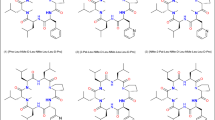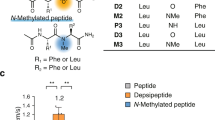Abstract
Purpose. To evaluate a cyclic acyloxyalkoxycarbamate prodrug of a model hexapeptide (H-Trp-Ala-Gly-Gly-Asp-Ala-OH) as a novel approach to enhance the membrane permeation of the peptide and stabilize it to metabolism.
Methods. Conversion to the linear hexapeptide was studied at 37°C in aqueous buffered solutions and in various biological milieus having measurable esterase activities. Transport and metabolism characteristics were assessed using the Caco-2 cell culture model.
Results. In buffered solutions the cyclic prodrug degraded chemically to the linear hexapeptide in stoichiometric amounts. Maximum stability was observed between pH 3–4. In 90% human plasma (t 1/2 = 100 ± 4 min) and in homogenates of the rat intestinal mucosa (t - = 136 ± 4 min) and rat liver (t - = 65 ± 3 min), the cyclic prodrug disappeared faster than in buffered solution, pH 7.4 (t - = 206 ± 11 min). Pretreatment of these media with paraoxon significantly decreased the degradation rate of the prodrug. When applied to the apical side of Caco-2 cell monolayers, the cyclic prodrug (t - = 282 ± 25 min) was significantly more stable than the hexapeptide (t - = 14 min) and at least 76-fold more able to permeate (P app = 1.30 ± 0.15 × 10−7 cm/ s) than the parent peptide (P app ≤ 0.17 × 10−8 cm/s).
Conclusions. Preparation of a cyclic peptide using an acyloxyalkoxy promoiety reduced the lability of the peptide to peptidase metabolism and substantially increased its permeation through biological membranes. In various biological media the parent peptide was released from the prodrug by an apparent esterase-catalyzed reaction, sensitive to paraoxon inhibition.
Similar content being viewed by others
REFERENCES
V. H. L. Lee and A. Yamamoto. Adv. Drug Delivery Rev. 4:171–207 (1990).
V. Bocci. Adv. Drug Delivery Rev. 4:149–169 (1990).
X. H. Zhou. J. Controlled Release 29:239–252 (1994).
G. M. Pauletti, S. Gangwar, G. T. Knipp, M. M. Nerurkar, F. W. Okumu, K. Tamura, T. J. Siahaan, and R. T. Borchardt. J. Controlled Release 41:3–17 (1996).
R. A. Gray, D. G. Vander Velde, C. J. Burke, M. C. Manning, C. R. Middaugh, and R. T. Borchadt. Biochemistry 33:1323–1331 (1994).
W. A. Banks, A. J. Kastin, D. H. Coy, and E. Angulo. Brain. Res. Bull. 17:155–158 (1986).
H. Bundgaard. Adv. Drug Delivery Rev. 8:1–38 (1992).
R. Oliyai and V. J. Stella. Ann. Rev. Pharmacol. Toxicol. 32:521–544 (1993).
J. K. McDonald and A. J. Barrett. Mammalian Proteases: A Glossary and Bibliography, Vol. 2, Exopeptidases, Academic Press, New York, 1986.
F. W. Okumu, G. M. Pauletti, D. G. Vander Velde, T. J. Siahaan, and R. T. Borchardt. Pharm. Res. 12:S-302 (1995).
S. Gangwar, G. M. Pauletti, T. J. Siahaan, V. J. Stella, and R. T. Borchardt. J. Org. Chem. (submitted).
M. Inoue, M. Morikawa, M. Tsuboi, and M. Sugiura. Jpn. J. Pharmacol. 29:9–16 (1979).
F. M. Williams. Clin. Pharmacokinet. 10:392–403 (1985).
I. J. Hidalgo, T. J. Raub, and R. T. Borchardt. Gastroenterology 96:736–749 (1989).
P. Artursson. J. Pharm. Sci. 79:476–482 (1990).
M. Pinto, S. Robine-Leon, M.-D. Appay, M. Kedinger, N. Tradou, E. Dussaulx, B. Lacroix, P. Simon-Assmann, K. Haffen, J. Fogh, and A. Zweibaum. Biol. Cell 47:323–330 (1983).
G. Wilson, I. F. Hassan, C. J. Dix, I. Williamson, R. Shah, and M. Mackay. J. Controlled Release 11:25–40 (1990).
H. Liu, S. Ong, L. Glunz, and C. Pidgeon. Anal. Chem. 67:3550–3557 (1995).
P. F. Augustijns and R. T. Borchardt. Drug Metab. Dispos. 23:1372–1378 (1995).
C. S. Cook, P. J. Karabatsos, G. L. Schoenhard, and A. Karim. Pharm. Res. 12:1158–1164 (1995).
W. N. Aldridge. Biochem. J. 53:117–124 (1953).
K. Takahashi, S. Tamagawa, H. Sakano, T. Katagi, and N. Mizuno. Biol. Pharm. Bull. 18:1401–1404 (1995).
W. N. Aldridge. Biochem. J. 53:110–117 (1953).
D. S. Auld and B. Holmquist. Biochemistry 13:4355–4361 (1974).
S. Gangwar, S. D. S. Jois, T. J. Siahaan, D. G. Vander Velde, V. J. Stella, and R. T. Borchardt. Pharm. Res. 13:1657–1662 (1996).
Author information
Authors and Affiliations
Rights and permissions
About this article
Cite this article
Pauletti, G.M., Gangwar, S., Okumu, F.W. et al. Esterase-Sensitive Cyclic Prodrugs of Peptides: Evaluation of an Acyloxyalkoxy Promoiety in a Model Hexapeptide. Pharm Res 13, 1615–1623 (1996). https://doi.org/10.1023/A:1016472119387
Issue Date:
DOI: https://doi.org/10.1023/A:1016472119387




